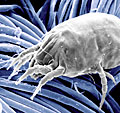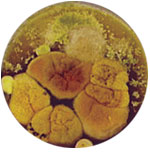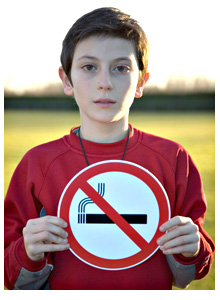How To Avoid Allergy & Asthma Triggers - February 2013
Triggers are substances or conditions in your environment that prompt allergy or asthma attacks. The U.S. Environmental Protection Agency (EPA) says that Americans spend up to 90 percent of their time indoors and that indoor allergens and irritants play a significant role in triggering asthma attacks as well as causing allergic reactions.
People are sensitive to different triggers, but some of the most common are: Dust Mite Allergen, Pollen, Pet Dander, Mold, Cockroaches, and Other Common Asthma Triggers. Read more below about allergen avoidance in your home to help prevent or reduce allergy and asthma symptoms.
 Dust mites are microscopic arachnids (spider family) that live almost everywhere on earth and are partial to beds, upholstered furniture, and carpet where they can burrow down. These are preferred habitats because dust mites thrive in a dark, humid environment with a good food supply from skin cells humans shed every day.
If you are one of the 20 million Americans allergic to dust mite allergens, you are probably familiar with waking up with a runny nose, watery eyes, and sneezing. If you have asthma, dust mites can bring on, or trigger, an attack.
That is, of course, unless you have taken steps to protect yourself from dust mites — specifically their dried excrement and dried body parts, both of which are allergenic.
Dust mites are microscopic arachnids (spider family) that live almost everywhere on earth and are partial to beds, upholstered furniture, and carpet where they can burrow down. These are preferred habitats because dust mites thrive in a dark, humid environment with a good food supply from skin cells humans shed every day.
If you are one of the 20 million Americans allergic to dust mite allergens, you are probably familiar with waking up with a runny nose, watery eyes, and sneezing. If you have asthma, dust mites can bring on, or trigger, an attack.
That is, of course, unless you have taken steps to protect yourself from dust mites — specifically their dried excrement and dried body parts, both of which are allergenic.
 Pollen season hits hardest in the spring and fall. If you are one of the 35.9 million Americans suffering from seasonal pollen allergies, you are keenly aware of when plants are producing pollen.
In the spring, trees, and grasses are the biggest pollen producers. In the fall, weeds are the main culprits.
While hay fever symptoms are largely caused by airborne pollen from ragweed flowers, much of the flower pollen in our gardens is not generally airborne — it is carried from plant to plant by insects and animals, so many flowers, thankfully, will not generally cause an allergic reaction.
Airborne pollen easily sticks to clothing, pets, and just about anything, so it is not difficult for pollen to hitchhike into your home in addition to floating in on the air.
The easiest way to reduce pollen allergy symptoms that can lead to asthma attacks is to reduce your exposure to pollen.
Pollen season hits hardest in the spring and fall. If you are one of the 35.9 million Americans suffering from seasonal pollen allergies, you are keenly aware of when plants are producing pollen.
In the spring, trees, and grasses are the biggest pollen producers. In the fall, weeds are the main culprits.
While hay fever symptoms are largely caused by airborne pollen from ragweed flowers, much of the flower pollen in our gardens is not generally airborne — it is carried from plant to plant by insects and animals, so many flowers, thankfully, will not generally cause an allergic reaction.
Airborne pollen easily sticks to clothing, pets, and just about anything, so it is not difficult for pollen to hitchhike into your home in addition to floating in on the air.
The easiest way to reduce pollen allergy symptoms that can lead to asthma attacks is to reduce your exposure to pollen.
 According to the American Academy of Allergy, Asthma & Immunology (AAAAI), pet hair is not the problem when it comes to pet-related allergies and asthma, so whether you pick a long-haired or short-haired pet, it really doesn't matter.
According to the American Academy of Allergy, Asthma & Immunology (AAAAI), pet hair is not the problem when it comes to pet-related allergies and asthma, so whether you pick a long-haired or short-haired pet, it really doesn't matter.
The problem is pet allergen, composed of dead skin cells that flake off like dandruff, saliva, and urine that dries and forms airborne particles that can be inhaled. No one wants to eliminate "the problem," that is, give away the family pet, but there are ways to reduce exposure to pet allergens and co-exist peaceably with these allergen producers. Mold reproduces by sending spores into the air to find a place to colonize. During transit, these mold spores can cause allergic reactions or asthma attacks.
Mold reproduces by sending spores into the air to find a place to colonize. During transit, these mold spores can cause allergic reactions or asthma attacks.
Avoidance is the best way to reduce the chance of mold-related outbursts and also lessen the potential for health consequences from mold exposure. Mold can grow anywhere and, like dust mites, prefers a dark, humid spot. Having a food supply is not a problem because mold will eat anything from decaying food and plant matter to wallpaper glue. Preventing the existence and growth of mold is your best defense. Cockroaches can cause allergy and asthma symptoms because they produce fine particles from dried feces and body parts, similar to dust mites. The Allergy & Asthma Foundation of America (AAFA) says that 23 to 60 percent of urban residents with asthma are sensitive to cockroach allergen.
Although sometimes it might be necessary to call a pest control expert to get rid of cockroaches, you can take a few steps to help prevent infestation.
Cockroaches can cause allergy and asthma symptoms because they produce fine particles from dried feces and body parts, similar to dust mites. The Allergy & Asthma Foundation of America (AAFA) says that 23 to 60 percent of urban residents with asthma are sensitive to cockroach allergen.
Although sometimes it might be necessary to call a pest control expert to get rid of cockroaches, you can take a few steps to help prevent infestation.
 There are three other triggers that commonly affect asthma sufferers that do not trigger allergy attacks: smoke, air pollution, and cold weather. Any type of smoke — from tobacco, fireplace, wood-burning stove, or burning yard debris — produces particles that can irritate the breathing passages and cause trouble for asthmatics. The same applies to air pollution — when particle counts or ground ozone counts are high, breathing can be difficult for asthma sufferers.
There are three other triggers that commonly affect asthma sufferers that do not trigger allergy attacks: smoke, air pollution, and cold weather. Any type of smoke — from tobacco, fireplace, wood-burning stove, or burning yard debris — produces particles that can irritate the breathing passages and cause trouble for asthmatics. The same applies to air pollution — when particle counts or ground ozone counts are high, breathing can be difficult for asthma sufferers.

Trigger: Dust Mite Allergen
 Dust mites are microscopic arachnids (spider family) that live almost everywhere on earth and are partial to beds, upholstered furniture, and carpet where they can burrow down. These are preferred habitats because dust mites thrive in a dark, humid environment with a good food supply from skin cells humans shed every day.
If you are one of the 20 million Americans allergic to dust mite allergens, you are probably familiar with waking up with a runny nose, watery eyes, and sneezing. If you have asthma, dust mites can bring on, or trigger, an attack.
That is, of course, unless you have taken steps to protect yourself from dust mites — specifically their dried excrement and dried body parts, both of which are allergenic.
Dust mites are microscopic arachnids (spider family) that live almost everywhere on earth and are partial to beds, upholstered furniture, and carpet where they can burrow down. These are preferred habitats because dust mites thrive in a dark, humid environment with a good food supply from skin cells humans shed every day.
If you are one of the 20 million Americans allergic to dust mite allergens, you are probably familiar with waking up with a runny nose, watery eyes, and sneezing. If you have asthma, dust mites can bring on, or trigger, an attack.
That is, of course, unless you have taken steps to protect yourself from dust mites — specifically their dried excrement and dried body parts, both of which are allergenic.
- The step doctors recognize as the most important is covering your bedding with mite-proof encasings. When your mattress, box spring, pillow, comforter, and other bedding are completely zipped into covers made of fabric impenetrable to dust mites and their allergen, you can avoid contact with this allergen while you sleep.
- Bedding that is not encased should be washed every 2 weeks in hot water to kill dust mites (or washed with a laundry additive or allergen laundry detergent that will remove allergens in any water temperature).
- Since carpet is another favorite spot for dust mites, removing the carpet or treating carpet regularly to kill dust mites and neutralize allergen is another important step. Upholstered furniture that can't be replaced with wood or leather can also be treated.
Often, the best protocol is to spray carpet and upholstered furniture every one to two months to neutralize allergens and treat the carpet and upholstered furniture twice a year to kill dust mites. - To keep the dust mite population low, keep the humidity in your home around 45%. A humidity gauge allows you to keep tabs on your home's relative humidity and know when a dehumidifier to remove moisture from the air would be helpful.
Trigger: Pollen
 Pollen season hits hardest in the spring and fall. If you are one of the 35.9 million Americans suffering from seasonal pollen allergies, you are keenly aware of when plants are producing pollen.
In the spring, trees, and grasses are the biggest pollen producers. In the fall, weeds are the main culprits.
While hay fever symptoms are largely caused by airborne pollen from ragweed flowers, much of the flower pollen in our gardens is not generally airborne — it is carried from plant to plant by insects and animals, so many flowers, thankfully, will not generally cause an allergic reaction.
Airborne pollen easily sticks to clothing, pets, and just about anything, so it is not difficult for pollen to hitchhike into your home in addition to floating in on the air.
The easiest way to reduce pollen allergy symptoms that can lead to asthma attacks is to reduce your exposure to pollen.
Pollen season hits hardest in the spring and fall. If you are one of the 35.9 million Americans suffering from seasonal pollen allergies, you are keenly aware of when plants are producing pollen.
In the spring, trees, and grasses are the biggest pollen producers. In the fall, weeds are the main culprits.
While hay fever symptoms are largely caused by airborne pollen from ragweed flowers, much of the flower pollen in our gardens is not generally airborne — it is carried from plant to plant by insects and animals, so many flowers, thankfully, will not generally cause an allergic reaction.
Airborne pollen easily sticks to clothing, pets, and just about anything, so it is not difficult for pollen to hitchhike into your home in addition to floating in on the air.
The easiest way to reduce pollen allergy symptoms that can lead to asthma attacks is to reduce your exposure to pollen.
- When the pollen count is high, it is a good idea to stay indoors and keep windows and doors in your home and vehicle closed as much as possible.
For those who cannot do without some of that fresh spring or crisp fall air, a window screen filter over an open window can greatly reduce the amount of pollen entering your home. - If you like the freshness of line-dried laundry, don't put clothes on the outdoor clothesline on days with a high pollen count.
- Check the pollen forecast for your area and try to stay indoors when the count is especially high.
- Wipe off pets as they return indoors, and really try hard to keep them out of your bedroom during pollen seasons.
- Protect yourself with a mask if you must be outdoors at sporting events or doing yard work. Consider that it could be cheaper to pay someone else to cut the grass instead of paying for visits to the doctor.
- Filtering indoor air helps remove pollen. Change the furnace filter at the beginning of each season. Clean the air in a single room with an air purifier. The bedroom is the best place to start since you spend the most time in that room.
Trigger: Pet Dander
 According to the American Academy of Allergy, Asthma & Immunology (AAAAI), pet hair is not the problem when it comes to pet-related allergies and asthma, so whether you pick a long-haired or short-haired pet, it really doesn't matter.
According to the American Academy of Allergy, Asthma & Immunology (AAAAI), pet hair is not the problem when it comes to pet-related allergies and asthma, so whether you pick a long-haired or short-haired pet, it really doesn't matter.
The problem is pet allergen, composed of dead skin cells that flake off like dandruff, saliva, and urine that dries and forms airborne particles that can be inhaled. No one wants to eliminate "the problem," that is, give away the family pet, but there are ways to reduce exposure to pet allergens and co-exist peaceably with these allergen producers.
- Bathe your pet often to remove excess dander and moisturize the pet's skin to reduce the dry flakiness.
- Limit the time you are up close and personal with your pet. Keep the pet out of the person's bedroom with allergies or asthma. Let someone without allergies and asthma do the grooming.
- Between baths, wipe your pet to moisturize skin and remove dander.
Trigger: Mold
 Mold reproduces by sending spores into the air to find a place to colonize. During transit, these mold spores can cause allergic reactions or asthma attacks.
Mold reproduces by sending spores into the air to find a place to colonize. During transit, these mold spores can cause allergic reactions or asthma attacks.
Avoidance is the best way to reduce the chance of mold-related outbursts and also lessen the potential for health consequences from mold exposure. Mold can grow anywhere and, like dust mites, prefers a dark, humid spot. Having a food supply is not a problem because mold will eat anything from decaying food and plant matter to wallpaper glue. Preventing the existence and growth of mold is your best defense.
- Keep a sharp eye out for moisture on windows and walls, under sinks and refrigerators, in basements and crawl spaces. Promptly clean mold and mildew off surfaces, and then treat with an anti-mold and mildew protective spray to prevent regrowth.
- Repair leaks promptly before mold gets out of hand. If the moldy area is more than 10 square feet, it may be advisable to seek professional help from a mold remediation expert.
- Keep the relative humidity in your home around 45%. A humidity gauge can help you know when you may need a dehumidifier to take excess moisture out of the air.
- Throw out moldy or mildewed articles that are hard to clean, such as books, toys, and shoes.
- Clean and treat bathrooms, basement walls, and furniture to remove mold and inhibit re-growth.
- Clean moldy surfaces and allow to thoroughly dry before painting. Don't just cover up mold – it will come through paint! A paint additive can help prevent the recurrence of the mold.
- Remediate more serious mold problems yourself or consult a licensed mold remediation expert.
Trigger: Cockroaches
 Cockroaches can cause allergy and asthma symptoms because they produce fine particles from dried feces and body parts, similar to dust mites. The Allergy & Asthma Foundation of America (AAFA) says that 23 to 60 percent of urban residents with asthma are sensitive to cockroach allergen.
Although sometimes it might be necessary to call a pest control expert to get rid of cockroaches, you can take a few steps to help prevent infestation.
Cockroaches can cause allergy and asthma symptoms because they produce fine particles from dried feces and body parts, similar to dust mites. The Allergy & Asthma Foundation of America (AAFA) says that 23 to 60 percent of urban residents with asthma are sensitive to cockroach allergen.
Although sometimes it might be necessary to call a pest control expert to get rid of cockroaches, you can take a few steps to help prevent infestation.
- Do not allow cardboard boxes and paper bags to accumulate. Get rid of cardboard storage boxes.
- Stack firewood well away from your home. Keep leaves and debris away from your home.
- Block all areas where roaches could enter the home, including crevices, wall cracks, and windows.
- Cockroaches need water to survive, so fix and seal all leaky faucets and pipes.
- Don't Feed Them! Keep food sealed, and kitchen surfaces free of crumbs.
Other Asthma Triggers: Smoke, Air Pollution, & Cold Weather
 There are three other triggers that commonly affect asthma sufferers that do not trigger allergy attacks: smoke, air pollution, and cold weather. Any type of smoke — from tobacco, fireplace, wood-burning stove, or burning yard debris — produces particles that can irritate the breathing passages and cause trouble for asthmatics. The same applies to air pollution — when particle counts or ground ozone counts are high, breathing can be difficult for asthma sufferers.
There are three other triggers that commonly affect asthma sufferers that do not trigger allergy attacks: smoke, air pollution, and cold weather. Any type of smoke — from tobacco, fireplace, wood-burning stove, or burning yard debris — produces particles that can irritate the breathing passages and cause trouble for asthmatics. The same applies to air pollution — when particle counts or ground ozone counts are high, breathing can be difficult for asthma sufferers.
- Simply stay away from smoke and pollution if possible.
- A mask can help capture particles when you cannot avoid smoke or have to be outside when air pollution levels are high.
- An air purifier can help remove particles from your home's air. Some have special filters that also remove odors.
- Keep an eye on air quality warnings, especially in hot or humid weather. The local weather report usually gives your area's Air Quality Index rating when air quality is poor.
Or check the EPA's AirNow website online for local air quality conditions and forecasts. Just type in your zip code at the top.
In addition to Local Air Quality Conditions, the EPA's AirNow AQI Basics website also provides a primer on helping you understand what local air quality means to your health.
Summary
Avoiding all allergy and asthma triggers is impossible, but every little bit of avoidance helps prevent unwelcome symptoms. We hope these tips will help keep you healthier.
